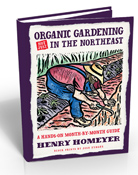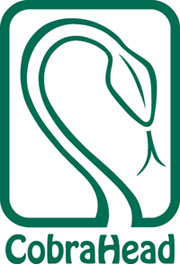Growing Roses and More
Posted on Thursday, March 13, 2025 · Leave a Comment
June is, traditionally, the month for weddings. It is also the time when old fashioned roses bloom, along with peonies, iris and many other great garden flowers. Is that coincidence? Perhaps. But maybe the two are linked. Let’s look at some great June flowers you can grow, and how to succeed with them.
My mom was an organic gardener who loved her roses. And although she is no longer with us to deny it, I think she may have cheated when it came to her roses. Back in the fifties and sixties roses were much fussier than they are now. They suffered from all kinds of fungal diseases and were eaten by ferocious Japanese beetles that made mincemeat of leaves and blooms. I think she used chemicals to kill the beetles and subdue the fungi.
Now we no longer have to resort to chemicals to have nice roses. Breeders have worked hard to develop roses that stay healthy and avoid predation from hungry beetles. The beetles were easy: they bred roses without scent to attract them. I don’t know how they developed roses resistant to diseases, but they have. I never see rose diseases, and I never spray.
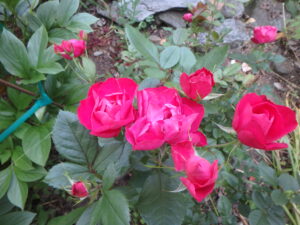
Knock out roses are reliable bloomers
My favorite roses are part of the “Knockout” series of roses, though I know others who really like the “Easy Elegance” series. They do not grow blossoms on long stems, but have multiple blossoms per stem. My “Knockouts” start blooming in June, bloom all summer, and up until hard frost – or even later.
Roses love full sun, but will grow in part shade. But the more sun they get, the better they do. Six hours of sunshine is considered full sun by most authorities. Afternoon sun is more potent than morning sun, so the west side of the house is better than the east.
Roses need good, rich soil. If you have sandy soil or a heavy clay, you will need to improve it in order to succeed. What does that mean? Mix in lots of compost when you plant, and add some organic fertilizer. Dig a hole that is at least 3 times as wide as the pot it was in when you purchased it. Mix the soil for the hole 50-50 with good compost- either your own, or a good bagged compost. I like Moo Doo or Coast of Maine brands.
Roses need more water than most other things, but do not want to sit in soggy soil. They should get an inch of water per week from rain, or a good dousing from your watering can applied slowly so it can soak in. A deep watering once a week is better than a little sprinkle every day.
Soil pH I important, too. The pH is a measure of the acidity or alkalinity of your soil. You can buy an inexpensive kit to test it, or send a sample out to be tested for pH and soil quality at your state Extension Service. Roses do best in slightly acidic soil – in the range of 6.0 to 6.8. If you soil has a lower number, you should add limestone and mix it in. But don’t add too much. A test should tell you how much to add.
Many roses are grafted onto rootstock. The bud union – a scar – should be buried in the soil. The scar is obvious on bare root roses, but is probably buried if you buy a rose in a pot. The colder the climate, the deeper that graft line or bud union should be. For Zone 4, it should be about 4 inches below the final soil line. Zone 5? 3 inches. Zone 6? 2 inches.
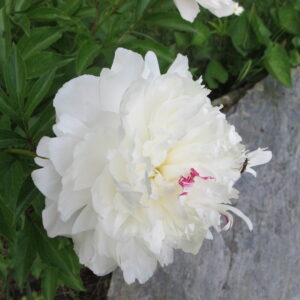
Peony ‘Festiva maxima’ that my grandmother grew
Want more blossoms? Roses do better if they get some fertilizer a few times during the course of the summer. An organic, slow-release bagged fertilizer called Rose Tone is designed just for roses, but I use Pro-Gro, my go-to organic fertilizer and sometimes use liquid fish and seaweed fertilizers made by Neptune’s Harvest. I add half a cup of Pro-Gro to the hole when I plant.
Other June flowers suitable for a wedding are peonies and iris. Peonies live forever if planted right – deep rich soil amended with plenty of organic matter. I have one from my grandmother, and she died in 1953. If you planted one that never blooms, you have probably planted it too deep. The “nibs” or growing points under the soil surface for next year’s growth should be no deeper than three quarters of an inch. You can feel them by poking around in the soil with your fingers. Pull away some soil if they are too deep, and it should bloom next year.
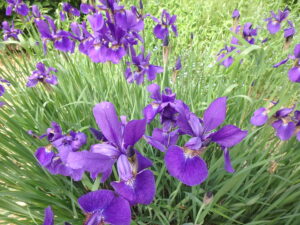
Siberian iris are tall and elegant
Siberian iris only bloom for a few days, but are magnificent. They come in a variety of blues and purples. Old patches tend to develop a dead spot in the middle because the plants have used up all the soil nutrients. Divide in the fall and re-plant, or add some organic fertilizer now.
There are too many gorgeous flowers to mention them all. But if you are planning a wedding, be advised that flowers do not bloom on an absolute calendar. Your favorite peony may bloom on June 15 this year – and June 21 or June 3 next year. You best bet is to have a good florist as a backup.
Henry is enjoying more time in his
garden, now that he only writes a column once a month. Feel free to send questions to him at
henry.homeyer@comcaset.net or PO Box 364, Cornish Flat, NH 03736. Please include a SASE if you wish an answer by regular mail.
Mid-Summer Blossoms
Posted on Tuesday, July 6, 2021 · Leave a Comment
Mid-summer is often a quiet time for flowers – many gardens have fewer dramatic blossoms than in the spring. I have made an effort to have plenty blooming now. It’s true that my Japanese primroses, peonies and Siberian iris have gone by. But I have many others, both old favorites and lesser-known beauties.
Beebalm ( Monarda didyma) has started early this year for me. Contrary to what most gardening books say, beebalm does not need full sun. In fact, full sun makes it dry out and go by more quickly. It does well in moist, rich soil but will grow anywhere. This year I planted some wild beebalm, a native prairie plant. Its scientific name is Monarda fistulosa, and some better garden centers are selling it now- even though it is not as flashy as its domesticated cousin. It’s a light lavender in color, and shorter than the standard varieties. It is terrific for butterflies and bees.
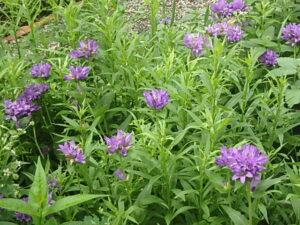
Campanula glomerata spreads by root but it is not a thug
Just finishing up for me is one of the bellflowers, clustered bellflower or Campanula glomerata. It stands about 24 inches tall with purplish-blue globes of small blossoms. It is a fast spreader, but pulls easily if it gets out of its place. A relative, peach-leaved bellflower ( C. persicifolia) is preferred by some, as it is better behaved. It has flowers growing up its tall stems, and comes in blue or white. Both species are good cut flowers.
Feverfew ( Tanacetum parthenium) has been used traditionally to cure many things, but I like it as a white cut flower with a yellow center. Each blossom is small – say half an inch – but there can be hundreds on a big plant. It is rambunctious. It sows seeds and shows up around my garden, but it is easily pulled. It keeps well in an arrangement.
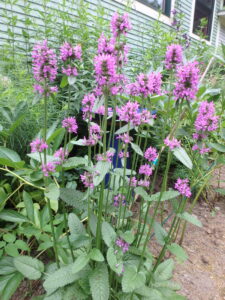
Betony humelo is a good cut flower
Betony (Stachys officinalis) is in bloom now, too. It is in the same genus as lamb’s ears, but has green, not silvery leaves, and sends up lovely purplish flowers on stiff stalks that look great in a vase. The best variety is one called ‘Hummelo’, named after the Dutch hometown of Piet Oudolf, designer of the High Line Gardens in NYC. But Hummel means bumblebee in German, which is appropriate – it attracts bees over its long bloom time. Small flowers appear all along its tall stems.
An uncommon flower in bloom for me now is called false hydrangea (Deinanthe caerulea) because the leaves are similar to those of the PeeGee hydrangea, although the flowers are totally different. This gem grows in full to part shade in moist, rich soil. It has small bluish-lavender cup-shaped flowers.
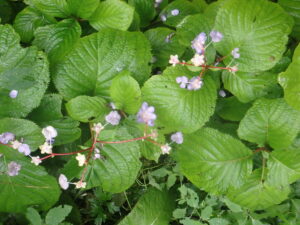
False hydrangea comes in blue or white blossoms
There is another false hydrangea, Deinanthe bifida, which has white flowers. Both are rated as hardy to Zone 5. I am in Zone 4 and have lost some plants, but others have survived.
A huge, dramatic plant is giant fleece flower (Persicaria polymorpha ). The blooms of this giant are a bit like astillbe flowers on steroids. The hollow stems stand up to 8 feet tall, and flower panicles are sometimes 18 inches from top to bottom. It does not spread by root, but each year the clump gets larger. I just cut back a good portion of mine, as the plant was shading out nearby plants. It would take a pickax and a strong back to dig it up – which I have, on one occasion. It likes moist soil and full sun,
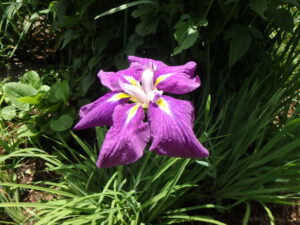
Japanese iris love wet places to grow
Moist soil is also good for Japanese iris (Iris ensata). In fact, it is often grown in shallow water. I have one clump which has just begun blooming – after all the others. Its foliage is similar to Siberian iris, but the “falls” or petals lie back flat, looking up. It does not like the competition of weeds, I have learned, as we weeded it well early on, and it is going to bloom dramatically this year.
Great masterwort ( Astrantia major ) has small domed blossoms in white or pinky-purple that look like pins stuck in a small pincushion, surrounded by delicate bracts (petal-like structures). Deer won’t eat it, and it blooms for weeks, preferably in moist, sunny locations. Each year my clumps get bigger and more wonderful.
At the front of a prominent flower bed I have installed lady’s mantle (Alchemilla mollis ), a tidy plant with lacy clusters of chartreuse flowers, a color that accents others nicely in a vase, or in the garden. It is probably best known for its tidy foliage which traps rain drops or dew and shows them off. It works as a ground cover, spreading a bit each year and providing dense foliage that helps reduce weeds. It will grow in full sun or light shade, but does not thrive in hot, dry soil.
In addition to perennials, each year I grow some annuals. Last year we started many dahlia tubers for their big, colorful blossoms, and saved the tubers indoors to reuse this year, and to share with others.
This year we bought some canna lilies for their interesting foliage – one variety has deep purple leaves – and bright orange or yellow flowers. They stand from two to six feet tall, and have been blooming consistently for a month so far.
If your garden is a bit short of flowers just now, try some of those mentioned above. There is always space for a few more flowers.
You may reach Henry at PO Box 364, Cornish Flat, NH 03746 or by e-mail at
henry.homeyer@comcast.net. He is the author of 4
gardening books.

